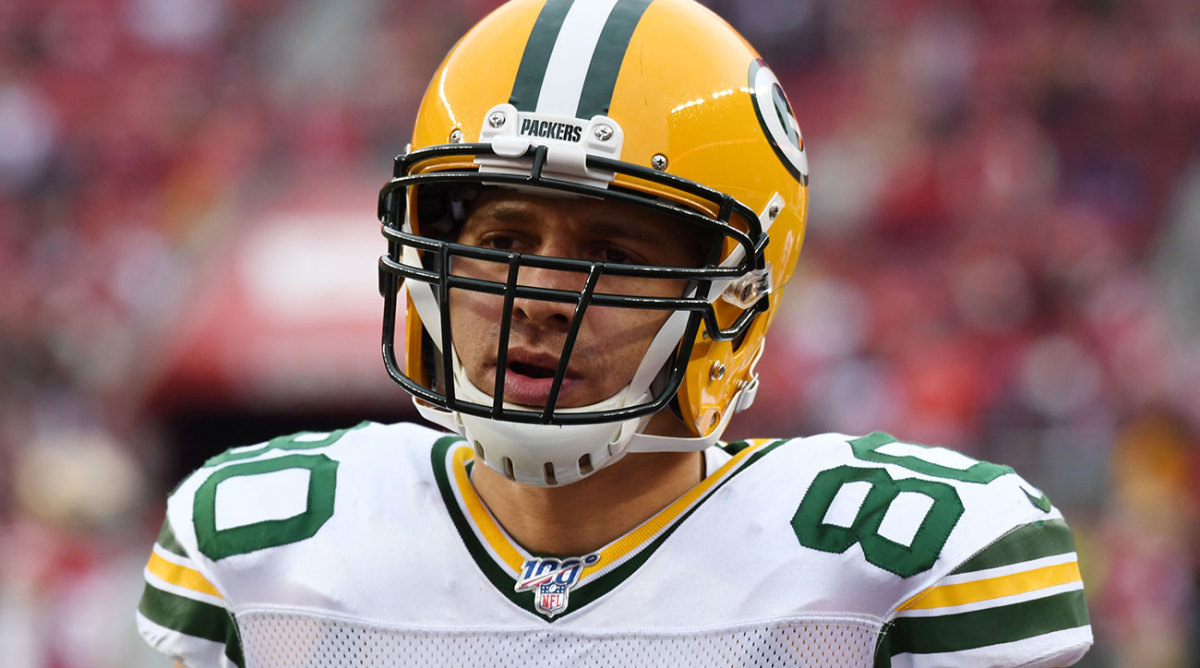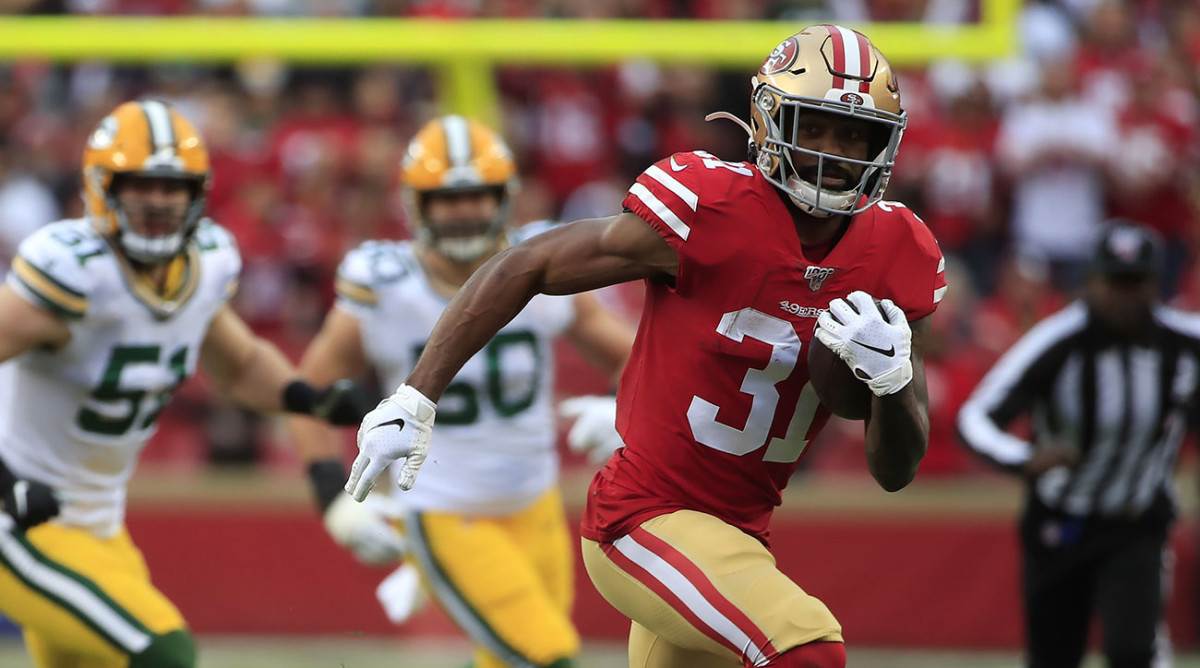Every NFC Team's Biggest Weakness Going Into 2020
No NFL roster is perfect, and oftentimes the imperfections end up mattering far more than the strengths. They are highlighted in the game plan. Attacked and exploited. And so in that way, the old saying is true: A chain is only as strong as its weakest link.
What is your favorite team’s weakest link? See here for the AFC, and we’ll dive into each NFC team below.
This year we have not had the benefit of watching beat writers mercilessly tweet each banal update from rookie minicamp and offseason training activities, thus this exercise lacks in a bit of perspective. Still, each team had its weaknesses going into the virtual offseason training program and will sustain those weaknesses amid the uncertain landscape since no interpersonal training can take place.
NFC EAST
Eagles
WIDE RECEIVER: Jalen Reagor and Carson Wentz have been working out together and could formulate the basis of a quarterback-receiver combination that Eagles fans have been pining for. There is little question that Philadelphia struggled with depth at the position, though, which is perhaps why they ran a majority of their offensive plays out of a 12-personnel grouping in 2019 (one running back, two tight ends, two wide receivers). They were one of four teams in 2019 that did not utilize a three wide receiver set in more than 50% of their plays. Meanwhile, the league is expanding. The Cardinals were using four wide receiver sets on 31% of their plays and seven teams used four-wide sets on more than 5% of their snaps.
Cowboys
SAFETY: Haha Clinton-Dix reunites with former coach Mike McCarthy to add a little bit of stability to this unit, though is it enough? There are reasons the Jamal Adams pipe dream persists, even if it oscillates from potentially true to merely a figment of a Cowboy fan’s imagination. What’s weird (and kind of amazing) about Dallas in 2019 is that in their three most commonly used defenses, they were a top-11 team in expected points added. They could effectively mask the presence of sub-par play at the position. In comes Mike Nolan to try and help after three years as the Saints’ linebackers coach. The Saints had one of the best base defenses in football last season and arguably some of the best safety play in the league last year.
Giants
QUARTERBACK: I think a more imaginative approach to the offense, and a healthy Saquon Barkley, will alleviate a lot of Daniel Jones’s struggles in 2019, as terrible and dated as that sounds. The Giants also theoretically improved their offensive line drastically with the selection of Andrew Thomas at No. 4 in the draft. Still, we’re going off what we know at the moment, and last year the Giants were incredibly ineffective throwing the ball especially against zone defenses. The Giants were also among the worst teams in the NFL against the blitz and when facing pressure.
Washington
CORNERBACK: Washington had one of the worst nickel defenses in football last year and played the personnel grouping on almost 60% of the snaps. Washington allowed an average opponent passer rating of 102.5 which, for perspective, was more than 40 points lower than the top-rated Patriots defense. The unit added Ronald Darby this offseason, which should help cement some of the cracks, as should the addition of Ron Rivera and one of the most formidable pass rushes in the NFL on paper.

NFC NORTH
Packers
LINEBACKER: I think anyone who saw the 2019 NFC championship game would side with me here. The linebacker position as a pass-rushing unit has promise, and, in fact, was a top-seven team when sending three-, four- and six-man pressure last year. However, the Packers struggled mightily against the run and were exposed often in man coverage. This would have been an interesting offseason to get younger and faster at the position. Mike Pettine’s defense works best when linebackers can effectively fade into coverage and amp up the theatrics of his simulated pressure looks. The offseason addition of Christian Kirksey doesn’t add much confidence to the unit in terms of a proven pass defender.
Vikings
EDGE RUSHER: Surprise, surprise. Mike Zimmer invested in cornerback play atop the draft (TCU's Jeff Gladney 31st overall, Mississippi State's Cameron Dantzler 89th), continuing a rich history of replenishment at the position. It’s probably a wise investment. As more teams shift to spread-out offenses and get rid of the ball quicker, pass rushing does not become irrelevant, but possibly less relevant than cornerback play. That said, the Vikings have lost more than they gained this offseason (so far). Last season the Vikings finished 26th in pass rush win rate.
Bears
TIGHT END: Without knowledge of how the position will work at the moment, we have to assume that, for the most part, the struggles of 2019 still remain. I would not be surprised if the Bears drastically altered their formation usage from a year ago (they were in 11-personnel with three wide receivers 64% of the time and 12-personnel with two tight ends just 10% of the time). At the moment, GM Ryan Pace has adopted the fire hose approach to solving this issue by signing a 33-year-old Jimmy Graham, drafting Cole Kmet and then signing enough backups and camp bodies to field a full indoor soccer team (the Bears have nine tight ends on the roster currently). While this will likely lead to a significant improvement, we don’t know what will happen yet.
Lions
DEFENSIVE LINE: This includes the Lions’ pass rush, which accumulated a league-worst 24% pass rush win rate and a less than ideal 21st in rushing yards surrendered. The Lions also parted ways with Damon Harrison, quite possibly the single most dominant run stopping force in the NFL over the past 10 years. This is not a team that can be fixed with the addition of one player, though the Lions’ coaching staff is certainly drafting that way.
NFC SOUTH
Saints
NONE: While the point of the exercise is to be as hyper-nitpicky as possible, how am I going to look at any part of this roster and make a valid argument against its strength? Sure, the linebacker position needs help, but am I really going to call a unit with Demario Davis a weak point? Yes, the cornerback position is a tad lopsided, which explains why Sean Payton can’t seem to stop dumpster diving in East Rutherford for cornerback help. But, am I really going to call a unit with Marshon Lattimore weak? The same thing can be said with nearly every position. Wide receiver, tight end, running back. How the hell hasn’t this team won the last three Super Bowls?
Falcons
CORNER/EDGE: The needy Falcons told on themselves as much, selecting both positions with their top picks in the 2020 draft. This was a team that played remarkably well down the stretch but needs to play even better in 2021, given how suddenly crowded and star-studded the division has become. While I don’t doubt Thomas Dimitroff’s ability to unearth gems with both A.J. Terrell and Marlon Davidson, both would need to do some convincing early in their rookie season to make me believe they don’t still need help at both spots.
Buccaneers
RUNNING BACK: At the risk of buying in too much, the more I look at this Buccaneers roster the more dangerous it appears. There are certainly some tiny dents, but so much of what is missing on the defensive side of the ball can be mitigated by Todd Bowles, who, in my mind, is one of the best five or six defensive coordinators in football. Running back sticks out because the quarterback and tight end positions got so much better in the offseason. Ronald Jones displayed some solid characteristics last year and was in the upper tier of running backs who faced a high percentage of loaded eight-man fronts (Jones ran against a stacked box on more than 25% of his carries).
Panthers
SAFETY: The Panthers were surprisingly adequate in their base nickel defense last year but struggled mightily across the board. They defended the run poorly, they were a middling pressure team and were merely OK against the pass. Drafting Jeremy Chinn certainly helps, and this is the puzzle I’m left with. Does he immediately, with no proof, make the safety group that much better, as opposed to, say, Derrick Brown making a struggling defensive line better?

NFC WEST
49ers
RUNNING BACK: There are some rosters where this exercise is relentlessly nitpicky. John Lynch and Kyle Shanahan have done a tremendous job seeking out positional value and should still have a formidable lineup with Tevin Coleman, Raheem Mostert and Jerrick McKinnon. Maybe safety is another place of some concern, but otherwise this roster is dangerously loaded.
Seahawks
CORNERBACK: The Seahawks were an odd team on paper last year, given that they had the 11th-best passer rating allowed, but also tied for fourth place in highest number of successful passing plays allowed. I do not doubt for one second John Schneider’s ability to unearth another group of unheralded stars at the position, and I also think the best is yet to come for Shaquill Griffin, who logged his first Pro Bowl season in 2019 and yielded fewer than 600 receiving yards to opponents in total.
Rams
LINEBACKER: Are the additions of third-round pick Terrell Lewis and former first-round pick Leonard Floyd enough to bolster a unit that is prone to mismatches? I thought Samson Ebukam played well, despite appearing in just 51% of the team’s snaps. He doesn’t miss a lot of tackles (9%, according to Pro Football Reference) and cut down on his opponent’s YAC, yards per target and yards per completion. Micah Kiser is also an intriguing unknown (relatively speaking) who could drastically improve the unit’s fortunes with good health.
Cardinals
OFFENSIVE LINE: Amid a potentially generational offensive tackle run at the start of this year’s draft, the Cardinals opted for Isaiah Simmons, the versatile linebacker from Clemson. Arizona’s offensive line is not bad as evidenced by a strong late-season running game resurgence (and, with Kyler Murray’s incredibly fast 2.73 second snap-to-throw time, does it matter as much?). They also finished 10th in ESPN’s Pass Block Win Rate percentage. Still, is it to the point that Kliff Kingsbury is confident that his offense can take the massive step forward the league is expecting, or could there be a 2019-Cleveland-type miscalculation made there?
• Question or comment? Email us.
